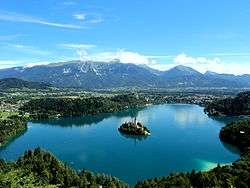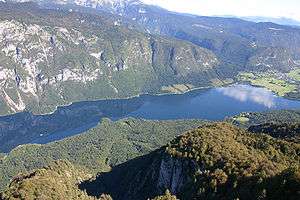Lake Bled
Lake Bled (Slovene: Blejsko jezero; German: Bleder See, Veldeser See) is a lake in the Julian Alps of the Upper Carniolan region of northwestern Slovenia, where it adjoins the town of Bled. The area is a tourist destination. The lake is 35 km (22 mi) from Ljubljana International Airport and 55 km (34 mi) from the capital city, Ljubljana. Lake Bled is 4.2 km (2.6 mi) from Lesce-Bled train station.
| Lake Bled | |
|---|---|
 Lake Bled seen from Little Osojnica Hill | |
| Location | Julian Alps |
| Coordinates | 46°21′52″N 14°05′41″E |
| Basin countries | Slovenia |
| Max. length | 2,120 m (6,960 ft) |
| Max. width | 1,380 m (4,530 ft) |
| Surface area | 1.45 km2 (0.56 sq mi) |
| Max. depth | 29.5 m (97 ft) |
| Water volume | 0.0257 km3 (0.0062 cu mi) |
| Surface elevation | 475 m (1,558 ft) |
| Islands | Bled Island |
| Settlements | Bled |
Geography and history
The lake is of mixed glacial and tectonic origin. It is 2,120 m (6,960 ft) long and 1,380 m (4,530 ft) wide, with a maximum depth of 29.5 m (97 ft), and it has a small island. The lake lies in a picturesque environment, surrounded by mountains and forests. Medieval Bled Castle stands above the lake on the north shore and has a museum.[1] The Zaka Valley lies at the west end of the lake.
The World Rowing Championships in 1966, 1979, 1989, and 2011 were held at Lake Bled.
Bled Island
The lake surrounds Bled Island (Blejski otok). The island has several buildings, the main one being the pilgrimage church dedicated to the Assumption of Mary (Cerkev Marijinega vnebovzetja), built in its current form near the end of the 17th century, and decorated with remains of Gothic frescos from around 1470 in the presbyterium and rich Baroque equipment.[2]
The church has a 52 m (171 ft) tower and there is a Baroque stairway dating from 1655 with 99 stone steps leading up to the building. The church is frequently visited and weddings are held there regularly. Traditionally it is considered good luck for the groom to carry his bride up the steps on the day of their wedding before ringing the bell and making a wish inside the church.
The traditional transportation to Bled Island is a wooden boat known as a pletna.[3] The word pletna is a borrowing from Bavarian German Plätten 'flat-bottomed boat'.[4] Some sources claim the pletna was used in Lake Bled as early as 1150 AD, but most historians date the first boats to 1590 AD.[5] Similar in shape to Italian gondolas, a pletna seats 20 passengers. Modern boats are still made by hand and are recognizable by their colorful awnings. Pletna oarsman employ the stehrudder technique to propel and navigate boats across the lake using two oars. The role of the oarsman dates back to 1740, when Empress Maria Theresa granted 22 local families exclusive rights to ferry religious pilgrims across Lake Bled to worship on Bled Island.[6] The profession is still restricted. Many modern oarsman descend directly from the original 22 families.[7]
Gastronomy
The area's culinary specialty, a cream pastry (kremna rezina or kremšnita 'Cremeschnitte'), was designated a protected dish of designated origin in 2016 by the Slovene government.[8] Although various Slovene cream pastries date back to the Habsburg era,[9] the current "official" recipe was created in 1953 by Ištvan Lukačević, the former manager of the Hotel Park's patisserie.[10] There is an annual festival dedicated to the pastry. It is estimated that 12 million cream pastries have been prepared at the Hotel Park’s patisserie over the last 60 years.[11]
See also
References
- Lake Bled Castle (https://safarinomad.com/lake-bled-castle/)
- Kermavnar, Simona; Turk, Matija. "Podružnična cerkev Marijinega vnebovzetja na Otoku na Bledu" [Assumption Chapel of Ease on the Island in Bled]. In Šmid Hribar, Mateja; Golež, Gregor; Podjed, Dan; Kladnik, Drago; Erhartič, Bojan; Pavlin, Primož; Ines, Jerele (eds.). Enciklopedija naravne in kulturne dediščine na Slovenskem – DEDI [Encyclopedia of Natural and Cultural Heritage in Slovenia] (in Slovenian). Retrieved 23 April 2013.
- "The Pletna boat - Bled". www.bled.si. Retrieved 2018-10-24.
- Snoj, Marko (2003). Slovenski etimološki slovar (2 ed.). Ljubljana: Modrijan. p. 527. ISBN 961-6465-37-6.
- "The Pletna boat - Bled". www.bled.si. Retrieved 2018-10-24.
- Sims, Davy (2018). Bled Slovenia. Firsthand Guides. p. 137. ISBN 9781977025357.
- "The Pletna boat - Bled". www.bled.si. Retrieved 2018-10-24.
- "A Slovenian resort is synonymous with a cream cake :: Prvi interaktivni multimedijski portal, MMC RTV Slovenija". www.rtvslo.si. Retrieved 2018-10-24.
- "Lake Bled Cream Cake: A Confection Straight from the Storybooks". 2015-10-02. Retrieved 2018-10-24.
- d.o.o., Renderspace d.o.o. & AV studio. "The original Bled cream cake - Sava Hotels & Resorts". www.sava-hotels-resorts.com. Retrieved 2018-10-24.
- "A Slovenian resort is synonymous with a cream cake :: Prvi interaktivni multimedijski portal, MMC RTV Slovenija". www.rtvslo.si. Retrieved 2018-10-24.
External links
| Wikimedia Commons has media related to Lake Bled. |
- Bled island website (in Slovene)
- Lake Bled Tourism (in English)

